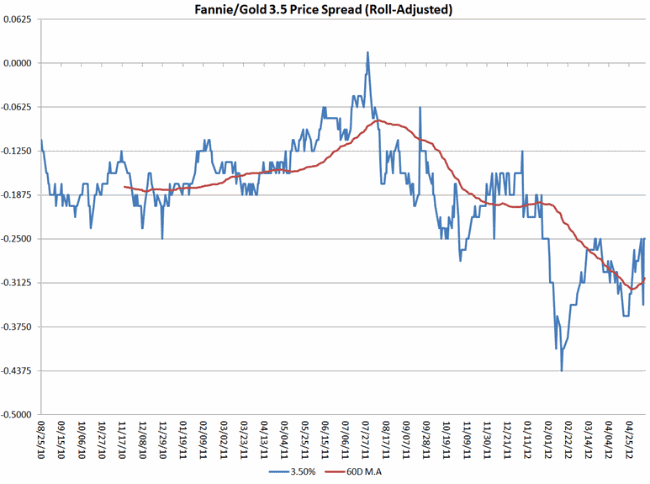One of the themes discussed at the MBA’s recent conference in New York was the idea of “a merger” of the mortgage-backed securities issued by Fannie Mae and Freddie Mac. The FHFA itself now lists one of its goals to "build a single securitization platform" in the Strategic Plan for 2013-2017 this morning. MBA President David Stevens recently addressed the concept, expressing concerns about the growing price and economic disparity between Fannie Mae and Freddie Mac securities.
Before continuing, it will be helpful to discuss the differences between the Fannie and Freddie securitization programs. Since it takes time for cash to be passed from servicers to the GSEs to and then to investors, both types of securities (as well as Ginnie Maes) pay investors after a “delay.” This is fairly simple in concept. All securities have a “record day” which determines who is the “holder of record” at any point in time. For agency MBS, the record day is always the 30th of the month. The actual cash (principal and interest) owed to the investor is then remitted to investors in the following month.
Fannie Mae always pays bondholders on the 25th day of the month following the record date; Freddie Golds pay on the 15th day of the following month. (Freddie Mac pools originally paid on the 15th day of the second month after the record date. In the late 80s/early 90s Freddie Mac created the Gold program, which moved the payment date up a month for fixed-rate pools; note that Freddie ARMs are still issued under the “green” program and have the old payment structure and delay.)
Because time has value, the shorter delay for Gold pools means that they should trade at a higher price than Fannies, assuming they are priced to the same yield and prepayment speed. At current levels, the constant-yield price of 30-year Gold 3.5s is roughly 2+ ticks higher than Fannie 3.5s. (The economic value of the delay difference is a function of a number of factors, including the pool’s coupon and yield.)
Despite the shorter payment delay, however, Gold pools have almost always traded at a concession to Fannies rather than at a premium. The differential is largely due to the liquidity difference between the two agencies’ securities. According to the MBA, daily trading volumes for Fannie MBS are 20 times larger than those for Freddie Golds. The relatively impaired liquidity of Golds implies wider bid/ask spreads, making trading in the securities more expensive; it also means that prices are more apt to be impacted by heavy trading volumes and/or increases in market volatility.
As a result, it is significantly more expensive for investors and issuers to trade in Golds, meaning that they need to trade at a concession to Fannies in order to compensate for their reduced liquidity and higher trading costs. The price differential between the two programs is also growing, as illustrated by the following chart showing the pricing difference between Freddie Mac Gold and Fannie Mae 3.5s over the last few years.

The 60-day moving average of the concession has widened from 2-3 ticks in the fall of 2011 to its current level of 9-10 ticks; as of the close on Monday 5/14 the spread was 9/32s. Keep in mind that this shows only the actual price difference; the economic difference (i.e., including the delay difference) is roughly another 2+ ticks wider over time.
There is an unfortunate circularity to the price/liquidity issue. The lower prices paid for Gold securities means that originators pricing to Gold execution are at a significant disadvantage relative to those using Fannies as their benchmarks; in order to offer comparable rates, they must factor lower profit margins into their pricing. As a result, fewer originators create Gold securities, which results in reduced float for the securities, which serves to further impair liquidity.
Interestingly, Stevens’ comments included one questionable statement. He was quoted following the speech as saying “…(A)nd the taxpayer subsidizes the lender for the difference between the two. Taxpayers will be saved hundreds of millions of dollars because the execution will no longer be subsidized." In the current market, with comparable g-fees for Fannie and Freddie, the cost of the price concession and inefficient execution is borne by the originators creating Freddie Mac pools.
However, without action to either combine the securities of Fannie and Freddie or somehow eliminate the price concession, the price and liquidity disparity is likely to grow worse, and issuance of Freddie pools will continue to shrink. The true cost to taxpayers will come in the future; over a longer horizon, it’s easy to imagine that the government will be forced to continue supporting an increasingly uncompetitive enterprise.





